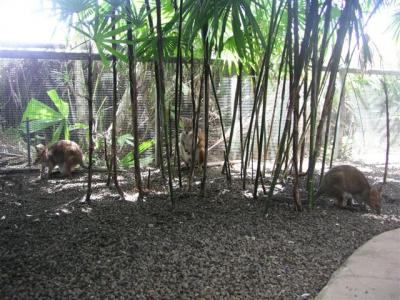On The Esplanade, a block or so from the marina is a casino. It is the building with the odd shaped black roof that you saw in the last post. We saw big casino signs on the building. We thought the roof design was just a neat architectural style, but we did find it odd that the casino has lots of trees growing along the roof line. There are big signs that say casino all over it. It turns out that upstairs portion of the building is a wildlife sanctuary where animals native to Queensland’s rain forest are on display, hence the unique roof with trees.
Near the entrance to the casino is the elevator that takes you up to the dome. You walk through the gift shop and up a flight of stairs into the sanctuary.
Inside there are all kinds of trees and bushes around, giving it a tropical forest feel. With the high ceiling, some of the trees were very tall. Birds were flying around and there was a big iguana looking thing walking down the walkway. It turns out that it is actually called a Boyd’s Forest Dragon. There is a walkway that loops around the bottom floor, with displays on both sides. The displays are quite large and most contain several different kinds of animals that cohabitate well together. Each display is a replica of the type of preferred environment of the animals living within it. Most of the displays have waist high glass walls, so you can lean over and get a close up look at the animals. The potentially dangerous animals are in full glass enclosures. There is a staircase that takes you up to a high walkway so you can walk along and look at the birds perched in the treetops. The roof and walls are actually a netting material, letting in the air from outside. The trees on the exterior mask that you are in a building and help with the tropical forest feel.
The feeding tour had just begun, so we joined in. We followed around the animal handler as she went from display to display putting out food for the animals. She told us about each animal and the food they eat. Many animals came out to eat, so we got to see and learn about a lot of animals that normally hide. The tour was very interesting and highly informative. Here are a few of the things we saw: boyd’s forest dragon, kookaburra, double eyed fig parrot, koala, red tailed black cockatoo, pied heron, rainbow lorikeet, sulphur crested cockatoo, metallic sterling, emerald dove, freshwater crocodile, bush stone curlew. The pictures below are in order.
Of special interest were the Papuan Frogmouths, which look like owls but are not part of the owl species at all. Then there were the pedamilions, which are a member of the kangaroo species and are, therefore, marsupials. Koalas are marsupials, too. Marsupials give birth to itty bitty young (jelly bean size) and the young live in a pouch on the mother’s belly until they are big enough to leave the pouch and live on their own. The pedamilion to the right is still a baby, out of the pouch for six months. The one in the middle hiding behind the bamboo is carrying a baby (called a joey) in it’s pouch. We can’t remember the name of the last little guy, but he is cute so we included him.

After the dome we went out to dinner, where Jaime tried sashimi (raw fish) for the first time. We are pleased to report we have another convert.

Those fotos were taken at the San Diego Zoo and you know it!! Glad you guys are doing well love seeing the updates….and of course living vicariously as always… Drive safe, Lindsey